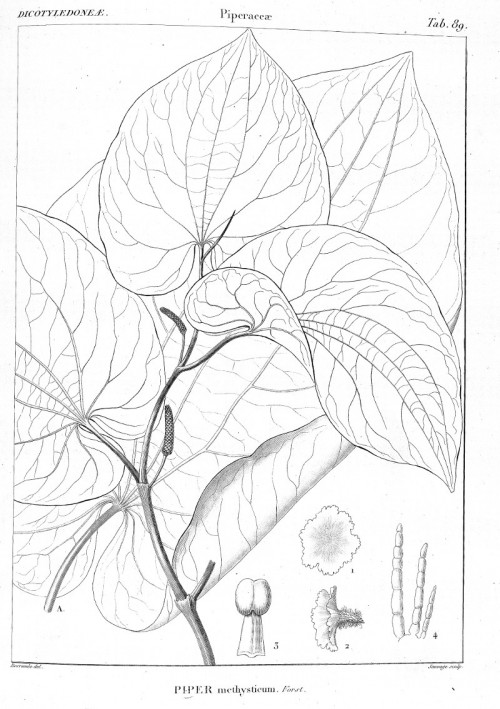Piper methysticum G.Forst. - syn.Piper inebrians Soland.; Macropiper latifolium Miq. - Piperaceae
kava, awa (Hawaii), Kava Kava
Evergreen shrub, up to 3m tall, native to the (western) Pacific Isles, cultivated on many Pacific Isles eg. Hawaii; stems thick, green or black, jointed with swollen nodes; leaves alternate, large, green, heart shaped, up to 20cm long;
„Kava cannot reproduce sexually. Female flowers are especially rare and do not produce fruit even when hand-pollinated. Its cultivation is entirely by propagation from stem cuttings… The roots of the plant are used to produce a drink with sedative and anesthetic properties. Kava is consumed throughout the Pacific Ocean cultures of Polynesia, including Hawaii, Vanuatu, Melanesia and some parts of Micronesia. Kava is sedating and is primarily consumed to relax without disrupting mental clarity. Its active ingredients are called kavalactones. “ http://en.wikipedia.org/wiki/Kava
„Kawa was traditionally prepared by chewing the root to soften it, then putting the chewed root in a calabash or special bowl, mixed with water, and pounded. The resulting liquid is drunk, often from a coconut cup, and followed by a piece of fruit to counteract the bitterness. In its traditional preparation, no negative effects are reported. However, recently kava lactones, thought to be the active ingredient in Kava, has been extracted and put into capsules which are sold as herbal supplements. There have been some reports of health problems resulting from over-use of these extracts.“ http://www.islandbreath.org/2007Year/13-hawaiiannature/0713-02Awa.html
„Traditional kava-kava extracts are prepared from macerated roots with water and coconut milk. Such extracts have been consumed over the last 2000 years without serious effects on health. The intoxicating effects of the beverage have been sought by the Western world as a beneficial alternative to alcohol in reducing anxiety and as a remedy for sleeplessness and menopausal symptoms. Various commercial preparations of kava-kava, such as
capsules, tinctures and fluid extracts, have been available in Europe and the USA…
In traditional kava-kava extracts, glutathione is extracted in a 1:1 ratio with kava lactones and these extracts have no reported side effects. The only recorded abnormality is a slightly raised γ-glutamyltransferase activity.
Based on the evidence discussed in this paper, the reason that kava lactones have been linked to hepatotoxicity is due to their dependence on the cytochrome P450 enzymes for clearance by the liver. The safe use of kava-kava has continued for many years and has been documented. In all traditional preparations of the kava root, the kava lactones are balanced by the availability of glutathione in the preparation. In the tablet and capsule forms of standardized extracts that relate to the reported cases of hepatotoxicity, only the kava lactones have been present in the products and no additional glutathione taken with the product.“
[Kava lactones and the kava-kava controversy. Whitton, P. A., Lau, A., Salisbury, A., Whitehouse, J., Evans, C. S., Phytochemistry, Vol.64(3), 2003, 673-679] http://www.henriettes-herb.com/files/pdf/kava_phytochemistry.pdf
„The culprit of kava hepatotoxicity will continue to remain a mystery in humans, if the underlying reaction is of idiosyncratic, unpredictable, and dose-independent nature due potentially to some metabolic aberration in a few individuals emerging from kava use. In addition, kava hepatotoxicity is presently not reproducible experimentally in preclinical models, as demonstrated by studies showing whole kava extracts are not hepatotoxic. This led us to propose our ‘working hypothesis’ that contaminant hepatotoxins including moulds might have caused rare kava hepatotoxicity in humans. Further studies are now warranted to proof or disproof our working hypothesis, because kava hepatotoxicity possibly based on contaminant hepatotoxins could be a preventable disease. In the meantime, however, for minimizing toxicity risk in kava users, a pragmatic approach should focus on the medicinal use of an aqueous extract derived from peeled rhizomes and roots of a non-mouldy noble kava cultivar, limited to maximum 250-mg kavalactones daily for acute or intermittent use.“
[Contaminant Hepatotoxins as Culprits for Kava Hepatotoxicity–Fact or Fiction?. Teschke, R., Sarris, J., Lebot, V., Phytotherapy Research, Vol.27(3), 2013, 472-474]

Delessert, B., Candolle, A.P. de, Icones selectae plantarum, vol. 3: t. 89 (1837)
http://plantgenera.org/species.php?id_species=797689
